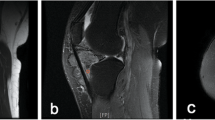Summary.
Because this disease is so rare the optimum treatment of pigmented villonodular synovitis (PVNS), in particular the diffuse form differs in the literature. The most important surgical procedures are arthroscopic and open synovectomy. The prevention of disease progression, as well as joint destruction and dysfunction, depends upon the early diagnosis of PVNS. During 1994 and 1995, we treated four cases of PVNS surgically and followed the patients for a time period of more than 12 months. Two patients were treated with complete synovectomy, one patient underwent partial synovial resection, and in the final case an arthrodesis was performed. Our results indicate that an MRI is essential for diagnosis and treatment planning. For the localized form of PVNS, it appears that a partial synovectomy is appropriate. However, in the event of diagnostic uncertainty or obvious diffuse involvement of the synovium, a total synovectomy is indicated because of the high recurrence rate. In our study, all four patients had disease involving secondary bony lesions and, in one case, joint destruction. Based on our findings, it is clear that early surgical therapy is the only recommended curative intervention. The decision regarding the surgical approach, arthroscopic versus open, depends on the form of PVNS, the extent of the disease and secondary changes of the joint.
Zusammenfassung.
Die Therapie der pigmentierten villonodulären Synovitis (PVNS), insbesondere der diffusen Form, wird weiterhin unterschiedlich beurteilt aufgrund der geringen Incidenz dieser Erkrankung. Die wichtigsten operativen Verfahren stellen die arthroskopische oder offene Synovektomie dar. Zur Vermeidung von Gelenkdestruktionen und funktionellen Einschränkungen ist die frühe Erkennung der PVNS entscheidend. In den Jahren 1994 und 1995 haben wir 4 Fälle operativ behandelt und in einem Zeitraum von mehr als 12 Monaten nachuntersucht. In 2 Fällen wurde die komplette Synovektomie, in einem Fall die partielle Resektion der Synovia und in einem weiteren Fall die Gelenkresektion und Arthrodese als offene Verfahren durchgeführt. Anhand unserer Ergebnisse ließ sich zeigen, daß das MRT unverzichtbar in der Diagnostik und der operativen Therapieplanung ist. Liegt ein lokaler Befall der Synovia vor, so scheint die partielle Synovektomie ausreichend. Bestehen aber Zweifel in der Einschätzung oder zeigt sich klar das Bild eines diffusen Befalls, sollte die komplette Synovektomie, aufgrund der hohen Rezidivrate der diffusen PVNS, bevorzugt werden. Es zeigte sich weiterhin, daß bei allen unseren Patienten sekundäre ossäre Läsionen auftraten bis hin zur Gelenkdestruktion bei einem Patienten. Daher ist die frühzeitige operative Therapie als z. Z. einzig kausale Behandlung zu empfehlen. Inwieweit arthroskopisch oder als offenes Verfahren vorgegangen werden kann, ist abhängig von der Form der PVNS, dem Ausmaß des Tumorbefalls und sekundären Gelenkveränderungen.
Similar content being viewed by others
Author information
Authors and Affiliations
Rights and permissions
About this article
Cite this article
Eisold, S., Fritz, T., Buhl, K. et al. Pigmentierte villonoduläre Synovitis Kasuistiken und Literaturüberblick. Chirurg 69, 284–290 (1998). https://doi.org/10.1007/s001040050414
Issue Date:
DOI: https://doi.org/10.1007/s001040050414




